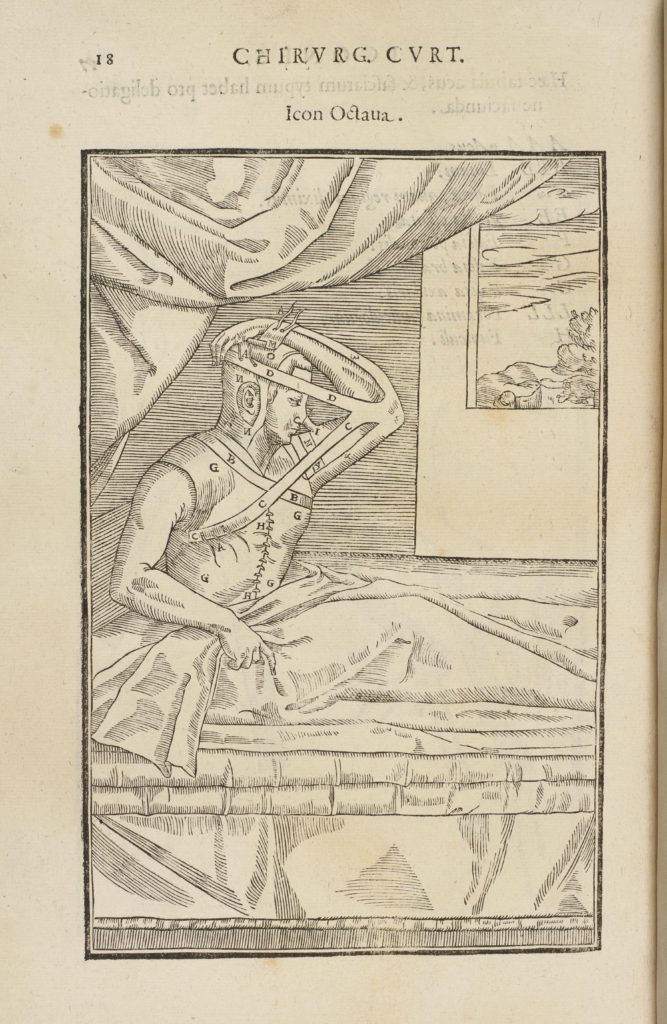
De curtorum chirurgia per insitionem was dedicated to Vincenzo Gonzaga (1562– 1612), duke of Mantua and Monferrato. It represented the culmination of his life’s work and gave detailed directions on reconstructive surgery on the nose, upper lip and ears. It is divided into two books the first of which concentrates on theory and context and the second on practice. A series of woodcuts illustrates the procedures and the necessary equipment, the majority of which relate to the operation for reconstructing the nose.
Tagliacozzi distinguished between surgery which enhanced beauty (chirurgia decoratoria) and remedial surgery (chirurgia curtorum) arguing that the face was important to a person’s sense of self and that the nose, amongst other things, was necessary for smelling, breathing (purifying the air in a way that oral breathing could not), and for proper speech. The lack of a nose, or the presence of an abnormal nose, could make a person appear monstrous and not fully part of the human race. Fortunio Liceti’s (1577–1657) De Monstrorum (On Monsters), first published in 1616, included both monsters with excessively large noses and those with no discernible nose. Thus, the replacement of a nose was necessary in order to allow a man to function fully in society.
The procedure described by Tagliacozzi gave the patient a nose formed from their own flesh but it was not without problems. The resulting nose was bulbous with discoloured flesh and the nostrils tended to close up over time. Given this, the use of a prosthetic nose was recommended by authorities such as Ambroise Paré (c. 1510–90). Tagliacozzi’s technique was that of grafting and is discussed in De curtorum chirurgia in relation to the horticultural practice of separate plants being joined together to form one. The nose reconstruction involved using a flap of skin from the upper arm that was then attached to the remains of the mutilated nose, at the same time remaining connected to the arm. Tagliacozzi estimated that the entire reconstruction would take between 91 and 136 days depending on the patient and the time of year at which treatment was commenced. Even after this the patient had to use tubes to keep the nostrils open and nose models to shape the nose for two years. Although the new nose was made with the patient’s own skin, it remained persistently foreign in its importation from another part of the body and its reluctance fully to replace the original nose.
The surgeon required at least two assistants and, at the point at which the graft was to take place, a tailor who provided a special jacket, which helped to keep the patient in the position necessary for the success of the graft. Like the assistants and the surgeon, the tailor is not shown in the woodcuts, which are focused on the patient and the equipment. His presence is attested to by the special vest and hood, with bandages attached, which the patient is shown wearing in plate 8. It could be said that two tailors were needed, for the surgeon himself acted as a tailor. Tagliacozzi’s instructions on cutting and shaping the skin flap are those for making and cutting a bespoke pattern. A paper pattern was cut to fit the defect of the nose and then laid on the arm flap, which was cut to size. The inner surface of the flap was freshened, the flap applied and fitted directly to the defect. In suturing, the stitches had to be even and exactly spaced, first marked out and then executed, beginning at the middle of the graft and working towards each side. God himself was a tailor who had formed the skin on Adam and Eve and, later given them clothing formed of the skin of other animals (Genesis 3:21). Skin and clothing had, in certain respects, similar functions. They provided a covering and formed and were formed by the person beneath. In this respect both surgeon and tailor ‘made’ men. Tagliacozzi claimed that the woodcuts in De curtorum chirurgia were intended to guide the surgeon, despite the fact that they do not always follow the instructions given in the text. However, together with the text, they suggest links between tailor, surgeon and God. In fashioning men using dust, skin, and cloth all used foreign or borrowed elements in the formation of the person.
Cordelia Warr, University of Manchester